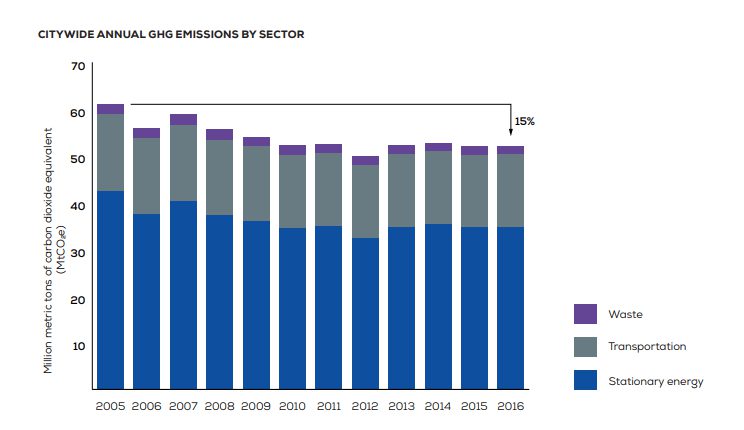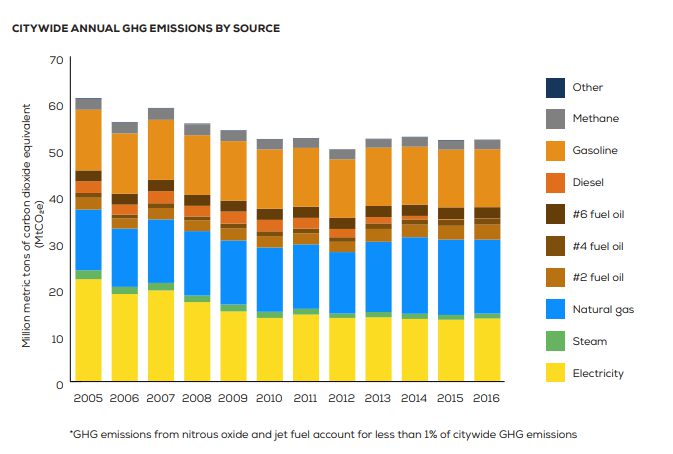Top: Photo of the smoke from the Carr Fire, outside Redding, California, used with permission from Shahzeen Attari, a researcher who works on environmental decision making at the individual level. The destructive capacity of the lengthening California fire season comes from a combination of factors, with a hotter, drier summer being one of them. New York City is formally committed to the Paris Agreement goals, which require rapidly curbing our emissions to allow the globe to stay below the 2°C target.
With this summer’s fires in California and in Athens, lethal floods and heat in Japan, and a warning for everyone that “The Global Heatwave Is About to Hit Your Wallet,” the upcoming Global Climate Action Summit this September is more important than ever; at the summit, mayors of the world’s largest cities are being invited to step up their climate action as part of the “One Planet Charter.” The C40 Cities signatories have committed themselves to deliver their contribution towards the goal of constraining global temperature rise to no more than 1.5 degrees Celsius above the pre-industrial average as stipulated in the Paris Agreement.
This article will report on what was discussed at the “C40 Financing Sustainable Cities Forum 2018” with a special focus on whether New York City itself is meeting its own commitments.
In September 2014, New York City committed to reduce greenhouse gas (GHG) emissions by at least 80 percent by 2050 (80 x 50, Local Law 66 of 2014), with an interim target to reduce emissions 40 percent by 2030 (40 x 30). The graph below shows that since 2005, NYC has reduced Citywide Annual Greenhouse Gas Emissions (GHGs) by 15% in 11 years. However, GHG emissions dropped the most by 2012 and rebounded after that, instead of following the downward trend.
Source: 1.5°C: Aligning New York City with the Paris Climate Agreement, September 2017, p. 43
NYC committed itself to reduce GHG emissions by at least another 25% within the next 12 years. Can the City keep this promise? And how? As measured by the standards of the UNFCC, the majority of NYC’s greenhouse gas (GHG) emissions come from two sources: buildings (67%) and transportation (30%).
[In fact, the largest single source in the city’s emissions is the jet fuel supplying Kennedy and LaGuardia airports. As with Paris and other major cities, in New York, jet fuel comprises almost a quarter of our total footprint, as can be seen in the last emissions report from the Bloomberg administration, which tracked commercial jet fuel (bottom of page 42). Aviation is regarded as a ‘Scope 3’ category, outside of current international climate agreements — so does not factor into the discussion in this post.]
This update will specifically look at the building and transportation sectors.
Let’s follow up on the City’s announcement on September 14, 2017 that NYC will be the first city to mandate that existing buildings dramatically cut greenhouse gas emissions (C40 at Climate Week: Cities have a 2020 Deadline).
This emission cut mandate introduced in 2017, after an initial try in 2016, has stalled again as last year’s City Council bill “Intro 1745,” mandating that building owners make retrofits to reduce emissions or face penalties, with a provision that building owners wouldn’t have to make the changes until 2030. Consequently, in 2018 a 80×50 Buildings Partnership convened by Urban Green is expected to release a framework to cut citywide building energy by 20 percent by 2030.
This past June, a Local Law (Int 0980-2018) was introduced to amend the administrative code of the City of New York to phase out the use of fuel oil grade no. 4 by January 1, 2025 (instead of 2030). In May, a Local Law (Int 0598-2018) to require that all city-owned buildings be powered by green energy sources by 2050 was enacted.
Transportation is one of the most significant contributors to climate change, accounting for 27% of global emissions and roughly a third of NYC’s emissions as per standard measurements. NYC is a member of the C40 Low Emission Vehicle (LEV) Network that focuses on areas of municipal action critical for facilitating the transition to LEVs. Each electric vehicle that displaces a conventional car saves approximately 1.5 tons of CO2 per year. As can be seen in the graph below, NYC’s largest sources of GHGs are combustion of natural gas (31%), use of electricity (25%) and combustion of gasoline (24%).
Source: 1.5°C: Aligning New York City with the Paris Climate Agreement, September 2017, p. 43
Just after the spring C40 conference, New Actuaries Climate Index™ summer 2017 data was released by organizations representing the actuarial profession in United States. The ACI seasonal value dips but remains at a high level. The five-year moving average of climate extremes across the two countries remains at the high recorded in winter 2016-17 and spring 2017. “Sea levels, high temperatures, and heavy precipitation continue to be pronounced relative to their historical norms,” said Doug Collins, Chair of the Climate Index Working Group.
Source: http://actuariesclimateindex.org/wpcontent/uploads/2018/04/Summer_2017_Press_Release-EN.pdf
WHY IS THIS IMPORTANT?
Two recent developments strengthen the case to act. One, the future of the National Flood Insurance Program is uncertain and is due to expire shortly on July 31, 2018. We do not know if or how much the federal government will assist in rebuilding our communities after the next Superstrom Sandy. Two, Moody’s a major credit rating agency, recently added climate to credit risks and warns cities to address their climate exposure or face rating downgrades.
The City’s report Aligning New York City with the Paris Climate Agreement 1.5°C states that “the actions NYC must take by 2020 have prolonged impacts to 2030 and beyond.” As NYC’s Chief Resiliency Officer Zarrilli stated at the conference, “it is time to lead and it is time to deliver.” We will know how effective today’s plans are depending on which scenario will be locked in.

